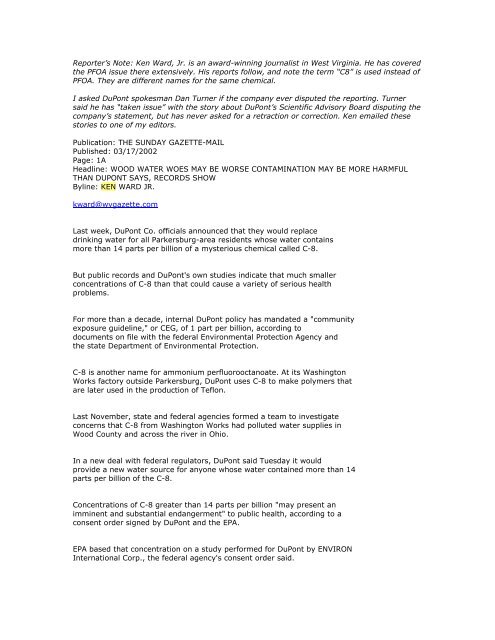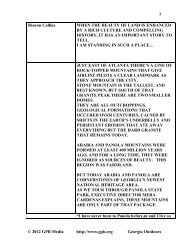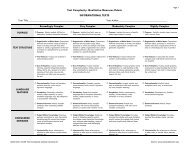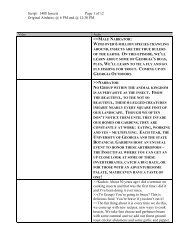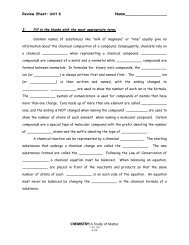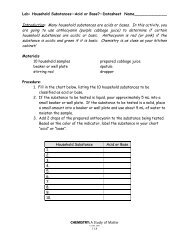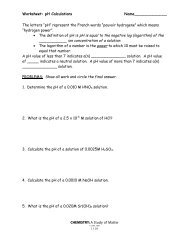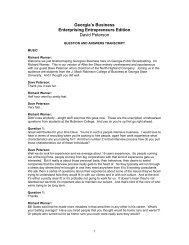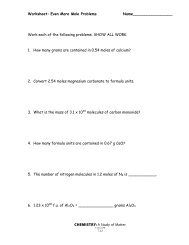PFOA stories
PFOA stories
PFOA stories
- No tags were found...
You also want an ePaper? Increase the reach of your titles
YUMPU automatically turns print PDFs into web optimized ePapers that Google loves.
animals through ingestion, inhalation and dermal contact," the consentorder said."Studies have also found that C-8 is persistent in humans and theenvironment. EPA is conducting a preliminary hazard assessment of C-8under the Toxic Substances Control Act."EPA Regional Administrator Don Welsh signed that consent order on March7. Five days later, EPA issued a news release to announce the move."This consent agreement is a proactive approach involving thecooperation of the state and federal governments, and private industryto ensure residents a safe drinking water supply," Welsh said in therelease.Under the EPA consent order, DuPont agreed to provide a temporary, newwater supply for anyone whose supply is found to have concentrations ofC-8 greater than 14 parts per billion.DuPont agreed to provide a new, permanent water supply for anyone whosewater is found to have levels of C-8 greater than the "screening level"developed under DuPont's separate deal with the state DEP.Under the DEP agreement, DuPont will help state and federal regulatorsdevelop that screening level. The screening level is defined as "theconcentration in a specific media such as air, water, or soil, that islikely to be without an appreciable risk of deleterious effects during alifetime in the human population."In an interview last week, EPA officials said they just don't know howmuch C-8 is dangerous."It basically isn't a regulated chemical," said Karen Johnson, chief ofthe safe drinking water branch at EPA's regional office in Philadelphia."So we don't have a lot of information about it."To contact staff writer Ken Ward Jr., use e-mail or call 348-1702.
Publication: THE CHARLESTON GAZETTEPublished: 07/19/2004Page: 1AHeadline: DUPONT'S C8 CONTAMINATION WIDESPREAD, EPA SAYSByline: KEN WARD JR.kward@wvgazette.comIn June 1984, officials from DuPont Co. put together a list of samplingresults from drinking water near the company's Parkersburg chemicalplant. The list, called "Update on C8 in water samples," was marked"personal and confidential."A March sample from Washington showed 1.2 parts per billion. A Junesample from Lubeck found 1.5 parts per billion.Over the next few years, DuPont found similar concentrations of C8, achemical it had used for decades to make Teflon products, in watersupplies downstream from its Washington Works plant.Along the way, in June 1991, DuPont had adopted a "Community ExposureGuideline" for C8 of 1.0 parts per billion. This guideline was set atthe level "expected to be without any effect" on people who are exposed.Now, after years of inaction, federal regulators have filed a major newpollution suit against DuPont, in part over these test results.When they filed the suit against DuPont on July 8, U.S. EnvironmentalProtection Agency officials alleged that the chemical giant has caused"widespread contamination" of drinking-water supplies near itsParkersburg plant.EPA officials also alleged that this pollution has created a"substantial risk of injury to health or the environment."In doing so, EPA has for the first time agreed with Wood Countyresidents who contend that DuPont has poisoned their water with itscontroversial chemical.EPA also threw its support behind charges that DuPont for more than 20years hid key information about the dangers of C8 from the governmentand the public.In a 31-page complaint, EPA said that DuPont "fails or refuses torecognize that its C8 contamination in public drinking water is ongoing,that C8 contamination extends into people's homes, and that DuPont hadnever informed [EPA] of levels of C8 contamination of drinking water
Staff Welfare Introduction of a wellness programme for railway staffat their work places. Ensuring proper rest for skilled and technical staffincluding the running crew. NID to design appropriate outfits for variouscategories of workforce.Training and Recruitment Over 80000 persons recruited in 2011-12; Over one lakh persons to be recruited in 2012-13 -backlog of SC/ST/OBC and other categories to bewiped off.Sports 7 Railway sportspersons honored with Arjuna Awardand Major Dhyanchand Award in 2011-12. 5 Railway sportsperson qualified for Olympics 2012. Development of a roadmap for railway sports. Institution of ‘Rail Khel Ratna’ Award for 10 railsportspersons every year.Concessions Value of concession granted to travelers is more than`800 cr per year. 50% concession in fare in AC-2, AC-3, Chair Car &Sleeper classes to patients suffering from ‘AplasticAnaemia’ and ‘Sickle Cell Anaemia’. Extending the facility of travel by Rajdhani andShatabdi trains to Arjuna Awardees. Travel distance under ‘Izzat Scheme’ to increase from100 kms to 150 kms.Suburban Services 75 additional services to run in Mumbai suburban. 18 additional services to be run in Chennai area. 44 new suburban services to be introduced in Kolkata. 50 new services to be introduced in Kolkata Metro in2012-13.Trains 75 new Express trains to be introduced. 21 new passenger services, 9 DEMU services and 8MEMU services to be introduced. Run of 39 trains to be extended. Frequency of 23 trains to be increased. Tariff Proposals Setting up of Railway Tariff Regulatory Authority tobe considered; Passenger fares increased by 10 paise per km for FirstClass; 15 paise per km for AC 2 tier and 30 paise perkm for AC I. Fares to be rounded off to the next nearest five rupees. Minimum fare and platform tickets to cost `5. Fuel Adjustment Component (FAC) in farescontemplated. Indian Railways has already started manufacturing ofnew generation 6000 HP electric locomotives and EMUs withregenerative braking feature at CLW and ICF respectively.Such technology will be implemented on more number oflocomotives and EMUs in future. DLW has set a new record by releasing 190 thHHP engine of 2011-12 on 31 st march. Last year it made150 HHP engines. Indian Railways has commissioned one wind mill plantof 10.5 MW capacity for ICF on 31.03.09. Two wind millpower plants of 10.5 MW capacity each one in Jaisalmer(NWR) and other in Tamil Nadu (SR) have been sanctioned.There is Proposal to set up wind mill plants of 72 MWcapacity in the states of Andhra Pradesh, Karnataka, Kerala,Tamil Nadu and West Bengal. Indian Railways have decided to eliminate unmannedlevel crossings by constructing Road Under Bridge(RUB)/subways in lieu of level crossing, by constructingdiversion road for merger of unmanned level crossing gate tonearby manned or unmanned gates or subway or RUB orRoad Over Bridge (ROB) and by closing unmanned levelcrossings having NIL Vehicle Unit where roads are nonexistenton either side. Railways have also decided toprogressively man such unmanned level crossings, whichcannot be eliminated by any other means. As on 1st April2011, there are 14896 unmanned and 17839 manned levelcrossings on Indian Railways. IRCTC has launched the scheme for booking Railwaye-tickets through mobile phone through its website i.e.irctc.co.in/mobile. Users can use their existing IRCTC user IDand password. After booking tickets through the mobilephones, users receive a reservation message with the ticketdetails. The service charges are similar to e-tickets i.e. ` 10/-per ticket for second/sleeper class and ` 20/- per ticket for allother classes. Internet facility using Wi-Fi has been presentlyplanned in three rakes of Howrah- Rajdhani Express only, as apilot project. It is a satellite based system using Wi-Fi fordistribution of internet bandwidth in coaches and likely datefor implementation of this system is September 25, 2012. Theestimated implementation cost of the project is ` 6.30 crore. DC-AC traction conversion work on the last segmentof Western railway’s suburban section was completed on 5 thFeb’12. With this, WR has bidden farewell to 84 year old DCtraction on its suburban network which was started in 1928. New train #22604/22605 has been introduced betweenVillupuram & Kharagpur from 17 th Feb. IR has received two national tourism awards on 29 thFeb. The Rewari steam locomotive shed was selected underthe category “Most unique / innovative tourism project” andNew Delhi railway station under the category “Touristfriendly railway station”. Rewari shed has a rare collection of9 working steam engines under one roof. NDLS station ishandling 5 lakh passengers daily. The first set of coaches for CMRL (ChennaiMetro) is getting ready at Alstom's plant at La Pa inBrazil. Out of 168 (42x4) coaches, the first four or ninerakes will be made in Brazil and shipped to Chennaiwhile the rest will be manufactured at a plant that isbeing set up near Sri City on the Tamil Nadu-AndhraPradesh border. S.Rly has made it mandatory for the contractors todisplay the price list of the standard food items at allthe stalls including the pantry cars of the trains. Railusers are requested to make all payments as per the tariffdisplayed and MRP printed on the packaged items. The Russian Prime Minister launched productionof wagons at the Tikhvin Railway Car Building Plant inLeningrad Oblast on January 30, to produce a wheel setevery 4½ min and complete a wagon every 24 min.
"Everybody thought DuPont was in hot water with the Bush EPA, butinstead it looks like they're sitting in the Jacuzzi," Cook said in aprepared statement.To contact staff writer Ken Ward Jr., use e-mail or call 348-1702.
Publication: THE CHARLESTON GAZETTEPublished: 05/07/2004Page: 3AHeadline: JUSTICES UNSEAL DUPONT C8 DOCUMENTS MEMOS DETAIL COMPANYLAWYERS' VIEW ON VULNERABILITY TO POLLUTION SUITByline: KEN WARD JR.kward@wvgazette.comDuPont Co. lawyers worried that the company was "vulnerable" to alawsuit over pollution of Wood County water supplies with the chemicalC8, documents released Thursday showed.In-house DuPont lawyer John R. Bowman warned that the company would"spend millions to defend these lawsuits and have the additional threatof punitive damages hanging over our head."In a November 2000 memo, Bowman advocated DuPont "getting out in frontand acting responsibly [to] undercut and reduce the potential forpunitives."Bowman wrote that he and another DuPont lawyer, Bernard J. Reilly, "havebeen unsuccessful in even engaging [company officials] in any meaningfuldiscussion of the subject."Our story is not a good one," Bowman wrote. "We continued to increaseour emissions into the river in spite of internal commitments to reduceor eliminate the release of this chemical into the community and theenvironment because of our concern about the bio-persistence of thischemical."Bowman's memo was one of three internal DuPont documents unsealedThursday by the state Supreme Court.The records - including one called the "Win for DuPont" document -detail the views of company lawyers about DuPont's liability for C8contamination of area water supplies.DuPont had argued the documents were internal, but had beeninadvertently released to lawyers for area residents.On Thursday, justices voted 5-0 to unseal the documents.In a prepared statement issued Thursday, DuPont lawyer Tom Flaherty saidthat the company was disappointed by the court's action."The documents in question offered individual opinions that do not
epresent the opinions of DuPont," Flaherty said."DuPont is confident that the trial will provide an opportunity to rebutthe claims and allegations made in this case with the facts andscience," he said. "DuPont believes that once a jury hears those facts,they will conclude that C8 at trace levels found in the community doesnot harm the members of the community or the environment."In his memo, Bowman said that DuPont should have sought to provide a newdrinking water source for Lubeck, one of the first communities where C8showed up in city water supplies.Bowman said he talked to lawyers from Exxon and the firm Archer andGreiner about lawsuits over water contaminated with the gasolineadditive MTBE."They told me that experience has told them it is less expensive andbetter to remediate or find clean drinking water for the plaintiffs thanto fight these suits," Bowman wrote."I think we are more vulnerable than the MTBE defendants because manystates have adopted a drinking water guideline for MTBE and it is notbio-persistent," he wrote. "My gut tells me the bio-persistence issuewill kill us because of an overwhelming public attitude that anythingbio-persistent is harmful."In the "Win for DuPont" memo, a DuPont lawyer said that the company'sgoals were to "not create [the] impression that DuPont did harm to theenvironment" and to "keep [the] issue out of press as much as possible."That memo listed the company's weaknesses as "permit exceedances,""chemicals in the groundwater and stream," and a letter in which thecompany promised to only dispose of "non-hazardous" materials in its DryRun Landfill.Also, the memo said that DuPont needed "background" research on U.S.District Judge Joseph R. Goodwin. At the time, Goodwin was hearing arelated case over C8 exposure from the Dry Run dump.At its Washington Works plant south of Parkersburg, DuPont has used C8for more than 50 years in the production of Teflon. In their lawsuitagainst DuPont, residents alleged that the chemical giant has known fordecades that C8 was harmful to humans, but concealed that knowledge fromthe public. Trial is scheduled to start in September.To contact staff writer Ken Ward Jr., use e-mail or call 348-1702
Publication: THE SUNDAY GAZETTE-MAILPublished: 03/06/2005Page: 1Headline: BOTH SIDES HOPE FOR ANSWERS ON C8Byline: KEN WARD JR.kward@wvgazette.comPARKERSBURG - Joe Kiger had never heard of C8. He didn't know what <strong>PFOA</strong>was. He sure didn't know anything about ammonium perfluorooctanoate.Then, in October 2000, Kiger got a letter from his water company, theLubeck Public Service District.Lubeck officials warned that they had discovered C8 in the water theyprovided to Kiger's family and 8,000 other homes.But they told customers not to worry. DuPont assured them that the waterwas safe, the letter said.That wasn't good enough for Kiger."Curiosity got me," the former labor union official turned schoolteacherrecalled last week. "I wanted to find out what this was all about."Eventually, Kiger's curiosity led him to hire a lawyer. Kiger became oneof the 13 named plaintiffs representing a now-estimated 80,000 peoplewho alleged DuPont polluted their drinking water.Last week, Kiger and other residents near DuPont's sprawling WashingtonWorks plant south of Parkersburg got what they wanted - or at leasttheir first big step in that direction.On Feb. 28, a Wood County judge gave final approval to a $107.6 millionsettlement.Judge George W. Hill Jr. said that the class-action lawsuit againstDuPont "certainly has served a good purpose to this community."As part of the settlement, DuPont will pay $10 million or more toprovide new equipment to remove most of the C8 from local drinking watersupplies.About $5 million of DuPont's money will pay for an independentscientific team to figure out if C8 is harmful to humans.And, in a move dreamed up and insisted on by the residents' lawyers, upto $70 million more will fund a first-of-its-kind, massive communityhealth study.In the end, supporters of the deal hope to find out not only if C8 canmake people sick, but also if exposure to it can be tied to any ailmentsresidents have already suffered."We want to know the answer," Kiger testified in a settlement hearinglast week."I asked questions and time and time again couldn't get the answers," hesaid. "Now, we will find out."On this one thing, DuPont's critics and company officials agree: Bothwant answers.
For its part, DuPont believes that the science study funded by thesettlement will ultimately exonerate the company and its chemical."At the end of the day, DuPont is a science company," said LaurenceJanssen, one of the company's lawyers."We believe in science," Janssen said. "We want to put this issue torest if we can, and we believe we can with this science panel."An Unregulated ChemicalAt its Washington Works plant, DuPont has used C8 for more than 50 yearsin the production of Teflon. The popular product is best known for itsuse on nonstick cookware, but it is also used in everything fromwaterproof clothing to stain-repellent carpet and ball-bearinglubricants.In court documents, one DuPont executive testified that the companyearns about $200 million a year from products made with C8.For years, C8 - and DuPont's emissions of it into the air and water -have been basically unregulated. Residents downstream from theWashington Works plant complained to government agencies for years, butgot little action.In the last few years, C8 has come under increasing scrutiny.Last month, members of the EPA's Science Advisory Board urged the agencyto elevate its cancer-causing classification for the chemical and do amore thorough review of the substance.In a draft study, EPA had characterized C8 as a "suggestive" carcinogen.But advisory board members said that the evidence may indicate that thechemical is a "likely" carcinogen.The Washington, D.C.-based Environmental Working Group said that EPA'sdraft study ignored evidence that links C8 to heart attacks, breastcancer, testicular cancer and other ailments.In September 2002, EPA launched a "priority review" of C8's dangers,largely in response to new information about its toxicity that lawyersfor Wood County residents uncovered as part of the lawsuit.Last year, EPA also sued DuPont in a case that could prompt more than$300 million in fines against the company. Based again on evidenceuncovered by the residents' lawyers, EPA alleged that DuPont hadillegally withheld data about potential dangers of C8 exposure.DuPont is fighting that EPA suit, and is lobbying the agency seeking tohave the federal study conclude C8 is not harmful.'An imminent and substantial threat'When he got the letter about his water, Joe Kiger called everybody hecould think of - the county health department, the state DEP, thefederal EPA."There was a chemical in our water - why was it there?" Kiger said heasked. "Nobody seemed to know. All I was being told was that it was anunregulated chemical."
Finally, someone from the EPA regional office in Philadelphia helped hima little.The EPA official told Kiger he was going to send him some information.Kiger should read it, the official said, and then he would probably wantto find himself a lawyer.What the EPA official sent Kiger shocked him."I became very alarmed," Kiger said. He called Bilott and "That's whatstarted this whole thing."The EPA official had sent Kiger a copy of a March 6, 2001, letter thatCincinnati lawyer Rob Bilott had sent to more than a dozen state andfederal government officials.At the time, Bilott represented Wilbur and Sandra Tennant.After repeatedly seeking help from regulators and getting no action, theTennants had sued DuPont in 1999, alleging that the company's C8pollution made them sick and killed hundreds of their cattle.Bilott told EPA that lawyers for the Tennants had evidence that C8 fromDuPont's facility "may pose an imminent and substantial threat to healthor the environment."Bilott urged EPA to join in the lawsuit against DuPont, and to force thecompany to "immediately cease all manufacturing activities" involvingC8. Bilott outlined dozens of documents that, he argued, showed DuPonthad known for years that C8 was harmful, but had hidden that informationfrom regulators and the public.After the letter was written, DuPont lawyer John Tinney sought a courtorder to block Bilott and other plaintiffs' lawyers from discussing theC8 issue publicly.In court papers, Tinney complained that Bilott's letter to EPA "couldeasily reach the mass media." Such publicity, Tinney said, "would resultin a bias against DuPont at the trial of this matter."U.S. District Judge Joseph R. Goodwin refused to gag Bilott and theother lawyers. DuPont eventually settled the Tennants' lawsuit for anundisclosed amount of money.Bilott and Tennants' other lawyers, though, continued to push state andfederal agencies to do something about C8.And, when Kiger called Bilott, the lawyers agreed to represent him andother residents who worried about the C8 in their water.'No human health effects'Throughout the case, and even with the settlement, DuPont continues tomaintain that "no human health effects are known to be caused" by C8.
At last week's hearing, lawyers announced that the study of this issue -being conducted as part of the settlement - will be done by TonyFletcher of the London School of Hygiene, David Savitz of the Universityof North Carolina School of Public Health, and Kyle Steenland of EmoryUniversity.The panel will evaluate available scientific evidence to determine ifthere is a link between C8 exposure and any human disease, includingbirth defects.Janssen said that initial results of the study should be completedwithin 12 to 15 months."Their main charge is to go with all deliberate speed, but no matterwhat, to do it right," Janssen said.Plaintiffs' lawyer Larry Winter, who with Janssen picked the scientists,said that the study would be "thorough and unprecedented.""There is a tremendous amount of interest in this process nationally andinternationally," Winter told the judge.While the three scientists are doing their study, other medical expertswill be surveying the health of residents downstream from the DuPontplant.Planning for that survey has already been going on for five months.Plaintiffs' lawyers advanced money out of their own pockets so that theproject could get started before the settlement was finalized.Dr. Paul Brooks, a physician and one of two former hospitaladministrators, said the survey would gather residents' medicalhi<strong>stories</strong> and try to estimate potential C8 exposure.Blood samples from residents who agree to that part of the survey willbe screened in 50 or 60 ways. Tests will look for cancer markers, organfunction and C8 levels.Eventually, the survey should give some answers about whether residentswith great C8 exposure are more or less likely to have suffered fromvarious diseases.Brooks hopes that most of the work can be done in about a year. Nocommunity health survey "of this magnitude" has ever been done anywherebefore, Brooks said."It's important that we determine scientifically what effect C8 has hador will have in the future on the health status of those individuals whohave been exposed," Brooks said.More than that, Brooks said, the study will provide a wealth ofinformation about other facets of the community's health. All of theresults - without individual names or other identifying features - willbe placed in the public domain."It's going to be an enormous amount of information," Brooks said. "Ithink it will be a gold mine [for health researchers]."To contact staff writer Ken Ward Jr., use e-mail or call 348-1702.
Publication: THE SUNDAY GAZETTE-MAILPublished: 08/21/2005Page: 6BHeadline: CAUTION URGED FOR CONTACT WITH C8Byline: KEN WARD JR.kward@wvgazette.comVINCENT, Ohio - On Monday night, more than 200 people gathered in thesteamy hot auditorium of Warren High School to find out if pollutionfrom a DuPont Co. chemical plant is making them sick.Dr. Edward Emmett of the University of Pennsylvania's School of Medicinedelivered the good news: A landmark government-funded study found nolink between C8 exposure and any illnesses. No connection to liverdisease. No signs of kidney problems. No indication of thyroid maladies.Still, Emmett recommended that residents near the DuPont WashingtonWorks south of Parkersburg not drink water contaminated with thecompany's toxic Teflon ingredient.If C8 isn't making people sick, why should people worry about drinkingwater polluted with it?First, Emmett said, there were important limits to what his studyexamined. It did not consider whether C8 causes cancer or leads todevelopment problems in children.Second, Emmett said, absent more concrete information about those twoissues, he believes residents should remain cautious."I think it's really prudent," Emmett said. "There is a differencebetween knowing something is harmful and being able to say that it'ssafe."Emmett said that caution is especially important for children and olderresidents, who were found to have the highest concentrations of C8 intheir blood."We can't explain all of the health effects, and I'm pretty concernedthat the level is high in the very young," Emmett said."We may not be able to say it's harmful, but do we know it's safe?That's another thing," Emmett said. "We haven't seen any harm, but wecan't say that this is safe."
The announcement of Emmett's findings was another significant chapter inthe continuing controversy over C8 and DuPont's emissions of it.The study is believed to be the first independent review of how C8exposure might affect an entire community's health. Generally, previousstudies - many funded by DuPont and other chemical makers and some byplaintiffs' lawyers - examined effects on plant workers and onlaboratory rats.C8 is another name for perfluorooctanoate, and is also known asperfluorooctanoic acid, or <strong>PFOA</strong>.At the Washington Works plant, DuPont has used C8 for more than 50 yearsin the production of Teflon. The popular product is best known for itsuse on nonstick cookware, but C8 is also used in everything fromwaterproof clothing to stain-repellent carpet and ball-bearinglubricants.For years, C8 and DuPont's emissions of it have basically beenunregulated.Fueled in large part by information uncovered by lawyers suing DuPontover C8 pollution, the U.S. Environmental Protection Agency has launcheda priority review of the chemical's dangers. The EPA has also suedDuPont for allegedly hiding information about C8 toxicity, and thecompany is facing a criminal investigation for concealing data about thechemical's hazards.Last August, DuPont agreed to pay more than $107 million to settle theclass-action suit on behalf of more than 50,000 current and former plantneighbors whose water was tainted with C8.Much of the money will fund a detailed review by private scientists ofC8's dangers and a landmark community health study in the Parkersburgarea. The company has also offered to pay for new water treatmentsystems to remove C8 from local water supplies, and will pay for bottledwater for the Little Hocking Water Association customers until the newtreatment systems are installed.Under the settlement, DuPont could be on the hook for another $325million in future medical monitoring if the studies find C8 could makepeople sick. On top of that, the company may also face additionallawsuits if residents actually get sick from C8 exposure.In press releases and at last week's meeting, Emmett has taken greatpains to emphasize that his work is not related to the legal wranglingover C8's potential dangers or DuPont's liability in releasing it intothe environment.
Funded through a four-year grant from the National Institute ofEnvironmental Health Sciences, the Emmett study is independent of anycorporation, law firm or class-action lawsuit.In his work Emmett sought to measure levels of C8 in the blood of Ohioresidents who live across the river from the Parkersburg plant. Hefocused on four communities - Belpre, Little Hocking, Cutler and Vincent- that receive their drinking water from the Little Hocking WaterAssociation. The survey examined blood samples and a variety of healthinformation of 326 residents from 160 randomly chosen households.Emmett also wanted to find out if most C8 exposure for humans came fromdrinking water or from the air they breathe. Finally, he sought to learnif this exposure put residents at a greater risk of getting sick.Last month, Emmett reported in a news release that his work had foundthat residents who depend on C8-contaminated drinking water have 60 to80 times more C8 in their blood than the general U.S. population.The average American is believed to have about 5 parts per billion of C8in his blood.Residents studied by Emmett averaged about 340 parts per billion. Thefigures varied, depending on whether customers worked at DuPont, gotwater only from the Little Hocking system, and some other factors.Emmett compared C8 blood levels in Little Hocking water customers wholive upwind and downwind from the Washington Works plant. He found thatthe C8 levels were comparable. From that, he concluded that drinkingwater, not air emissions, is the most significant source of C8 exposure.As part of his study, Emmett compared C8 levels in residents' blood toother blood tests commonly used to detect liver, kidney and thyroiddiseases.Emmett found no connection, a conclusion that was praised by DuPontofficials and publicists who attended last week's meeting.Bill Hopkins, the Washington Works plant manager, said that Emmett'sresults were "very consistent with what DuPont's own findings havebeen.""We believe there are no known health effects, and that's what we heardhere tonight," Hopkins told reporters after the meeting.But Emmett said he found some things in his study that have him worried.
For example, Emmett found that residents who ate more locally grownfruits and vegetables had significantly higher concentrations of C8 intheir blood."It went up as the number of servings increased," Emmett said.Emmett said he is concerned because he cannot fully explain the finding."I wish I knew what was happening," he said. "Is the C8 in the fruit orvegetables, or is it in the cooking water, or does it have nothing to dowith that?"In response to Emmett's findings, the Washington-based EnvironmentalWorking Group, which has been following the C8 issue, published a"briefing memo" with its take on the study.The group emphasized that Emmett "did not assess the most sensitivehealth effects linked to the Teflon chemical in lab studies - cancer anddevelopmental harm."Last year, a scientist working for lawyers suing DuPont found thatpeople living near the Parkersburg plant had high rates of prostatecancer in men and cervical and uterine cancer in women. The study alsofound elevated rates of less common cancers such as non-Hodgkin's,leukemia and multiple myeloma.And in late June, an EPA science advisory panel urged the agency, in adraft report, to list C8 as a "likely human carcinogen."Emmett said that his study did not examine nearly enough people toproperly consider C8's potential to cause cancer. He said that thelarger health review launched as part of the lawsuit settlement shouldbe large enough to look at the issue.Last week, the private firm doing that health study said that 20,000residents had signed up so far to take part. The firm, Brookmar, hopesthat 60,000 to 80,000 eventually take part.Until more detailed answers are available, Emmett said residents shouldseek alternate water sources - such as the bottled water DuPont agreedto fund for Little Hocking customers - until water treatment systems areinstalled to filter out the C8.Emmett specifically advised parents not to use the polluted water tomake infant formula and called his findings on children's blood levels"the exact opposite of what we would want to see from a public-healthperspective."
Emmett's C8 findings highlight what critics say is a major weakness inthe way the federal government regulates toxic chemicals.In June, the Government Accountability Office reported that existing lawprovides only "limited assurance" that the 700 new chemical compoundsentering the marketplace each year are safe."EPA does not routinely assess existing chemicals, has limitedinformation on their health and environmental risks, and has issued fewregulations controlling such chemicals," the GAO report said.Two years ago, the Environmental Working Group issued its own reportthat urged Congress to require detailed testing to prove chemicals aresafe before people are exposed to them."Industry must be required to prove the safety of a new chemical beforeit is put on the market," the report said.To contact staff writer Ken Ward Jr., use e-mail or call 348-1702.
Publication: THE SUNDAY GAZETTE-MAILPublished: 07/03/2005Page: 1AHeadline: DUPONT LAWYER EDITED DEP'S C8 RELEASESByline: KEN WARD JR.kward@wvgazette.comIn early March 2002, state environmental regulators planned to warn WoodCounty residents that the toxic chemical C8 was spreading across thearea through air emissions from DuPont Co.'s Parkersburg plant."It is increasingly likely that the chemical is being spread in severalways - in groundwater, in the soil and now by air," said a draft newsrelease written by then-Department of Environmental Protection spokesmanAndy Gallagher.But the public never got that news. The DEP killed its release aftercomplaints from a DuPont lawyer, according to records obtained under thefederal Freedom of Information Act.Last week, Gallagher confirmed in an interview that Dee Ann Staats, atoxicologist hired as the DEP's science adviser, insisted that DuPontreview, edit and approve all C8-related statements issued by the state."I thought it was a strange policy," Gallagher said. "I fought againstthat, because I thought we were withholding information."In the case of the March 2002 news release, the DEP was to announceplans to expand testing of water supplies around the DuPont plant. DEPofficials felt that the testing was needed to map contamination ofdrinking water with C8.At the time, agency officials were telling Gallagher that they were alsobecoming worried that C8 was spreading through air emissions."Water testing area expanded around Parkersburg DuPont plant as concernover airborne spread of chemical grows," said the headline onGallagher's news release.After DuPont objected, Gallagher first edited all mention of airemissions from the release. Then, he scrapped it altogether - because ofDuPont's complaints, according to the records.In a sworn statement filed with the U.S. Environmental ProtectionAgency, Gallagher explained that DuPont regularly reviewed and editedDEP news releases concerning C8 issues.
Jessica Greathouse, the DEP's current communications chief, said that itwas wrong for DuPont to be allowed to edit a government agency's pressreleases. She said the practice no longer occurs."Under my watch, it's not appropriate," Greathouse said. "Press releaseswritten by me or anyone on my staff are under our editorial control."Gallagher, a former Gazette and Associated Press reporter, was the DEP'stop communications official from 1998 until 2002. He left the agencyafter making negative statements about Massey Energy Co. in theentertainment newspaper Graffiti.Gallagher discussed details of DuPont's involvement in DEP pressreleases in a sworn statement in the class-action lawsuit filed by WoodCounty residents whose drinking water has been contaminated with C8.Gallagher was questioned by lawyers for the residents and lawyers forDuPont during a May 2004 deposition in Charleston.In February, EPA lawyers filed Gallagher's statement and relateddocuments with an administrative law judge as part of a suit thatalleges DuPont covered up information about C8's dangers.The Sunday Gazette-Mail obtained the records from the EPA through a FOIArequest.C8, or ammonium perfluorooctanoate, has been used by DuPont since 1951at its Washington Works plant south of Parkersburg.Since that time, C8 - and DuPont's emissions of it - have essentiallybeen unregulated by state and federal agencies.Fueled in large part by internal DuPont documents uncovered by lawyersfor Wood County residents, the EPA began a detailed study of thechemical. DuPont also sued the EPA, for hiding information about C8'sdangers. A federal grand jury also is investigating potential criminalviolations by the company.Previously, DuPont had been through two regulatory investigations of C8without facing major restrictions on its use or emissions of thechemical.In December 1996, DuPont agreed to pay $200,000 in fines and upgrade itsDry Run landfill to resolve complaints that pollution from the dump waskilling area cattle and deer.
That settlement included no limit on the amount of C8 that could bedischarged from the landfill into nearby Dry Run Creek.Currently, the state Environmental Quality Board is considering a DEPmove to renew the landfill's permit for another five years - again withno limit on C8 emissions.In November 2001, Gov. Bob Wise's administration agreed to form a teamthat included DuPont representatives to study C8 and decide how muchexposure is safe. Since then, the DEP has issued a series of reportsstating that current levels of C8 exposure from the Washington Works arenot harmful.In writing those reports, the DEP used teams of scientists that includedDuPont representatives.Lawyers for Wood County residents asked to have their own experts serveon the teams, but Staats and then-DEP Secretary Michael Callaghanrefused.In his sworn statement, Gallagher said that he told Staats it was amistake not to have a citizen representative take part in the study."I was always looking to the sensitive nature of how it might beperceived by the public, how DEP was dealing with the issue, and I justthought it was a matter of fairness and balance that if we were going tohave a company official on we should have somebody representing thepublic," Gallagher said in his statement.Gallagher said that Staats "just did not want to upset the company." Hesaid that she was "particularly sensitive" to any mention in newsreleases that C8 was being spread by air emissions."She excised that from every news release that I ever recall dealingwith," Gallagher said. "She said that she didn't want that in there."Gallagher said he tried to issue the March 2002 news release withoutgetting prior approval from Staats and DuPont. Details of what happenednext are included in e-mail messages attached as exhibits to Gallagher'ssworn statement.Someone from the DEP - it is not clear who - e-mailed a draft of it to aDuPont hydrologist, who forwarded it to various company officials,including Ann Bradley, a Spilman Thomas & Battle lawyer who representsDuPont. Company officials then moved to block the release from goingout.
"I just spoke with Ann [Bradley], who reached Terry Headley and AndyGallagher in the DEP public information officer," wrote Dawn Jackson,then a DuPont public relations official, in an e-mail message to othercompany representatives."The attached news release has been sent to the media," Jackson wrote."Ann explained to Andy that releasing this kind of statement withoutinput from Dr. Staats is unacceptable, stated that we had had thisproblem before with statements containing errors being released withoutDr. Staats' approval, and asked that Andy Gallagher arrange a meetingwith WVDEP Secretary Callaghan. Andy said that the Secretary is out oftown, but he will set up something with his office when he returns."Gallagher tried to edit the release to address DuPont's concerns, butthe company was not satisfied."Ann Bradley, [DuPont official] Bernie Reilly and I conferenced brieflyjust a few minutes ago," Jackson wrote in an e-mail. "Ann had a chanceto speak with Dr. Staats, the science adviser for the state consentorder work, and she is furious that the press release was issued withouther review. She agrees with the need to speak with Secretary Callaghan."Jackson continued, "Also, Andy Gallagher called Ann back shortly before6 p.m. to tell her that he had issued a notice to the AP wire service topull the story that he had released earlier."Jackson wrote that if DuPont received any media inquiries about therelease, she would say, "We understand that the WVDEP has disavowed thatstatement, and it is appropriate that you contact them." She would thenrefer callers to Staats for any further comments.Last week, Bradley said she did not recall specifics, but that thecompany "identified factual errors in press releases."In Gallagher's deposition, DuPont lawyer Stephen Fennell asked about aMay news release.Bradley had reviewed it before it was issued. She corrected twomisspellings of the full chemical name for C8, and suggested using thephrase "reduce exposure levels" instead of "remediate" to describe therequirements of the company's 2001 consent order with the DEP.In an interview, Bradley said that she did not make a habit of editingthe DEP's news releases."There may have been one or two press releases, but I don't recall itbeing a routine matter," Bradley said.
Before joining state government, DEP Secretary Stephanie Timmermeyer wasa lawyer at Bradley's firm. Timmermeyer helped DuPont draft the 2001consent order with the DEP, records show.DEP officials say Timmermeyer does not get involved in C8 issues for theagency. No formal recusal arrangement has ever been put in writing.In his deposition, Gallagher said that Timmermeyer once called him whenshe was still with the Spilman law firm and "asked me to change a newsrelease.""I don't even remember what the details were," Gallagher said. "I toldher I would not, and we left it at that."Through a spokeswoman, Timmermeyer said that she did not remember thatincident."She does not recall having any conversation with Gallagher about pressreleases regarding DuPont, C8 or any subject," Greathouse said in ane-mail message.To contact staff writer Ken Ward Jr., use e-mail or call 348-1702.
Publication: THE SUNDAY GAZETTE-MAILPublished: 07/10/2005Page: 1AHeadline: DUPONT PROPOSED, DROPPED '81 STUDY OF C8, BIRTH DEFECTSByline: KEN WARD JR.kward@wvgazette.comMore than 20 years ago, the DuPont Co. found similar birth defects intwo of eight children born to women who worked at the company'sParkersburg chemical plant.A DuPont researcher said the number was "significantly greater" than theexpected rate of birth defects in the general population.In April 1981, the researcher proposed that DuPont do a detailed studyto determine if exposure to the toxic chemical C8 was to blame.Three months later, DuPont officials dropped the study, a former topcorporate doctor has testified.DuPont officials also decided not to report its preliminary findings tofederal regulators, according to the testimony, obtained under theFreedom of Information Act.Dr. Bruce Karrh, DuPont's former medical director, revealed thecompany's actions in a sworn statement in April 2004."To my knowledge, it was never reported to EPA, and, to my knowledge, Ididn't ask anybody whether it was reported," Karrh said of the birthdefects data.Karrh was questioned for two days by lawyers for Wood County residentswho sued DuPont over the contamination of their drinking water with C8.C8 is another name for ammonium perfluorooctanoate, or <strong>PFOA</strong>. DuPont hasused the chemical since 1951 at its Washington Works plant south ofParkersburg to make Teflon and similar products.Since that time, C8 - and DuPont's emissions of it - essentially havebeen unregulated by state and federal agencies.An EPA science advisory panel has urged the agency, in a draft report,to list C8 as a "likely human carcinogen."
Last August, DuPont agreed to pay more than $107 million to settle aclass-action lawsuit on behalf of more than 50,000 current and formerplant neighbors whose water was tainted with C8.Much of the money will fund a detailed review by private scientists ofC8's dangers and a landmark community health study in the Parkersburgarea. Town meetings to explain the health study are scheduled to kickoff Monday night in Parkersburg.Under the settlement, DuPont could be on the hook for another $235million in future medical monitoring if the studies find that C8 canmake people sick. On top of that, the company also might face additionallawsuits if residents actually get sick from C8 exposure.DuPont said again last week that it continues to believe that "theweight of evidence indicates that <strong>PFOA</strong> exposure does not pose a risk tothe general public.""To date, no human health effects are known to be caused by <strong>PFOA</strong>, evenin workers who have significantly higher exposure levels than thegeneral public," said Robert Rickard, DuPont's chief toxicologist.Fueled in large part by internal corporate records uncovered by theresidents' lawyers, the EPA in April 2003 launched a high-priorityinvestigation of C8's dangers.In July 2004, the EPA sued DuPont for hiding important information aboutthe chemical's health effects. DuPont has announced that it has reacheda tentative settlement with the EPA, but neither side has disclosed theterms of the deal.At the same time, DuPont is facing a criminal investigation of itsactions related to C8.Late last year, EPA officials subpoenaed thousands of pages of documentsfrom the residents' lawyers. The records included sworn statements byresidents and DuPont officials, and previously undisclosed corporaterecords.As part of their lawsuit against the EPA, agency lawyers filed some ofthese records with an administrative law judge that is hearing the case.Those records are part of a public case file, but EPA officials wouldnot release them without a formal Freedom of Information Act request.Karrh's discussion of the DuPont birth-defect data appears to be thebiggest revelation in the previously undisclosed documents.
In his deposition, Karrh reported that a DuPont epidemiologist namedBill Fayerweather had proposed in April 1981 to do a detailed study of apotential link between C8 exposure and facial birth defects.Fayerweather estimated that the rate of such birth defects in thegeneral population was about two in every 1,000 people. If DuPont foundtwo such problems in 10 children of plant workers, the rate would be"significantly higher" than that of the general population, Fayerweatherfound.When he examined Washington Works employees, Fayerweather found twobirth defects out of eight live births.One child was born with an "unconfirmed eye and tear duct defect," theDuPont study found. The other was born with "one nostril and eyedefect," the study said.During a deposition, Rob Bilott, a lawyer for Wood County residents,showed Karrh photos of the children and asked him to describe them."The child has only one nostril," Karrh said of one of the children."Apparently, the right nostril is absent and it looks like there's somegrowth on the inner surface of the right eye, on the medial surface."Karrh said that when he learned of the children years ago, he askedanother DuPont doctor to look into the matter."He went back and did the evaluations that were asked of him, that Iasked for him to make," Karrh testified. "He came back to me and he wassatisfied that it was not workplace related."The other doctor never prepared a written report, and Karrh said he"didn't recall speaking with him about how he made that decision.""He satisfied me, and we moved on to other things that we were doing,"Karrh said.Just a month before Fayerweather proposed his study, 3M told DuPont thatit had found facial birth defects in baby rats exposed to C8.For years, 3M had supplied DuPont with the C8 it used. In 2000, 3Mstopped making the product, citing safety and environmental concerns.The DuPont birth-defect data has been made public before. But details ofDuPont's decision not to continue its study have not previously beendisclosed.
In April 2003, the Washington-based Environmental Working Group wrote tothe EPA to demand an investigation by the agency of DuPont's handling ofC8 issues.Among other things, the organization cited a 1981 internal company studythat found similar facial birth defects in two of eight women studied byDuPont. In a letter, group President Ken Cook complained that DuPontwrongly did not report the study results to the EPA.Under the Toxic Substances Control Act, or TSCA, companies must tell theEPA when they find information "that reasonably supports the conclusionthat [a chemical] presents a substantial risk of injury to health."In its lawsuit against DuPont, the EPA cited the same 1981 studydocument.But the agency did not mention the birth-defects findings. Instead, theEPA focused on blood sampling that showed that C8 was able to move frommothers to babies through the umbilical cord. Agency lawyers noted that,a year later, in March 1982, DuPont did tell the EPA about similarmovement of C8 from mother to baby in rat studies.The EPA said that if it had known DuPont found C8 being transferred frommother to baby in humans sooner, federal officials could have moved morequickly to study the issue and perhaps take steps to protect the public.DuPont has said, "there is no legal basis for the EPA's allegations.""The company contends that it has fully complied with statutoryreporting requirements and disputes any association between <strong>PFOA</strong> andharmful effects on human health or the environment," DuPont officialssaid in a prepared statement.In March 1982, 3M and DuPont met with EPA officials to discuss 3M's ratstudy. No one from DuPont mentioned the human birth-defects data."We did not see that there was evidence that there was a substantialrisk in those two possible cases of birth defects that could be relatedto C8 exposure," Karrh testified. "So, therefore, we made the conclusionthat there was not a reporting requirement on that."But it turned out that DuPont never really did the study that might haveturned up that evidence.By July 1981 - just three months after it was proposed - the C8birth-defects study was listed in company documents as being "on hold."
"There were so many other things going on," Karrh testified. "There wasno reason to do this study at that point in time, so, therefore, it wasdecided to put it on hold until we got the results from these otherstudies and then we could always go back and do it if we felt anindication for it."In 1978, Karrh wrote a scientific journal article that advised companiesto always report potential health threats from their chemicals toregulators."When it comes to such intensely emotional subjects as occupationallyrelated cancer and chronic illness caused by workplace conditions, acompany cannot risk the possibility of being placed in the compromisingposition of withholding information or making a false judgment about whoshould know what," he wrote. "It is the duty of every company'smanagement to discover and reveal the unvarnished facts about healthhazards."Why then, Bilott asked, did Karrh not tell the EPA about DuPont's humanbirth-defects data?"If you reported every little thing because it wasn't - just because itvery possibly a thousand years from now could be, then you'd lose thewhole purpose of it."To contact staff writer Ken Ward Jr., use e-mail or call 348-1702.
Publication: THE CHARLESTON GAZETTEPublished: 11/15/2005Page: 1DHeadline: FOOD WRAPPERS HAVE EXCESS C8, ENGINEER SAYSByline: KEN WARD JR.kward@wvgazette.comFrench-fry boxes, microwave popcorn bags and pet food containers couldcontain unsafe amounts of the toxic chemical C8, a longtime DuPont Co.chemical engineer testified last year in a lawsuit against the company.Glenn R. Evers, who left DuPont in 2002, said the company discovered theproblem but did nothing about it."We were out of compliance," said Evers, who received an internal DuPonte-mail that described the findings of a company study."It was one of these 'We are in deep trouble' memos," Evers recalled."Everybody who knew what the extraction limits were knew there was aproblem."DuPont sells a variety of products called telomers, some of which areused in grease-repellent coatings for food packaging.C8 is not used to make these products. But telomers are chemical cousinsto C8. Scientists believe that telomers break down to form C8. Theyworry that this breakdown could be at least partly responsible for widedistribution of C8 in the environment around the globe.DuPont says C8 is present in telomer products in only tiny amounts, anddoes not pose any public health threat."These products are safe," DuPont chemist Bob Bock said last week.The debate over the potential dangers of C8 that leaches from telomersis an emerging part of the ongoing battle over chemicals that helpcreate some of DuPont's best-known and most-popular products.C8 is another name for ammonium perfluorooctanoate, or <strong>PFOA</strong>. It is partof a family of chemicals called fluoropolymers. DuPont has used thechemical since the 1950s at its Washington Works plant south ofParkersburg to make Teflon and other similar nonstick andstain-resistant products.For decades, C8 - and DuPont's emissions of it - have essentially beenunregulated by state and federal agencies. Fueled in large part by
internal corporate records uncovered by lawyers for Wood Countyresidents, the EPA in April 2003 launched a high-priority investigationof C8's potential dangers.In September 2004, DuPont announced it would pay $107.6 million tosettle the residents' suit, which alleged the company poisoned drinkingwater for thousands of homes.During the months before the settlement, residents' lawyers obtainedsworn statements from a variety of current and former DuPont employees.In April 2004, Evers answered questions under oath from the residents'lawyers for nearly eight hours.During this interview, called a deposition, Evers said DuPont learnedfrom a 1966 study that chemicals like C8 can be transferred to food ifthey are used as package coatings. DuPont also knew from a study thatdogs that had been fed fluoro-chemicals like C8 developed enlargedlivers.When the EPA launched its C8 review, the agency said it was concernedabout studies that showed the chemical could cause development effectsin laboratory animals. Agency officials were also worried about researchthat suggests it may be linked to cancer.Researchers are finding that people around the world have C8 in theirblood. The blood levels may be generally very small, but it is unclearwhether these amounts are dangerous.For years, DuPont purchased the C8 it used from 3M. But in May 2000, 3Mannounced that it would phase out the product because of concerns aboutits safety.In his deposition, Evers said the 3M announcement had DuPont officials"licking their chops, saying there is $150 million worth offluorochemicals sales that we can jump into."Earlier, DuPont had worked out a deal with the federal Food and DrugAdministration to certify the use of its telomer products for foodpackage coatings, Evers testified.FDA officials told DuPont that this was a new product, and that thecompany should do a two-year study first, Evers said.In response, DuPont said it had found no health effects at less than1,000 parts per million of C8. The FDA said that wasn't good enough.
"It was a negotiating process," Evers testified. "What they did was theysaid what limit can we have that would be acceptable, and FDA said nohigher than 0.1 parts per million extractable. So that translates to apretty good safety margin for extraction."DuPont convinced the FDA that its product ZONYL RP would extract to arange of 0.1 to 0.25 parts per million, Evers said. "FDA said, 'Fine.You are certified,'" Evers said.Later, DuPont discovered that ZONYL RP was leaching more than 0.5 partsper million of C8 into food packaging, Evers said."What it meant was that we were out of compliance for that particularproduct," Evers said. "We shouldn't be selling it to the paper industry.More of the fluorochemicals product was extracting from the paper intowater than what FDA allowed."DuPont officials declined to answer specific questions about Evers'testimony.Instead, the Wilmington, Del.-based company issued a general statementthat it "does not sell any product or material into the paper industrythat has not been approved for its regulated use by the U.S. Food andDrug Administration.""DuPont products are compliant with all FDA applications and are safefor their intended uses," the statement said.An FDA spokesman could not be reached for comment on Evers' testimony.Previously, FDA officials have said that they do not believe the levelsof C8 in food packaging are a threat to public health.In July 2004, the EPA sued DuPont for allegedly hiding importantinformation about C8's potential health effects from regulators.Under federal law, DuPont could face more than $300 million in civilfines.But, DuPont and the EPA have said they have reached an "agreement inprinciple." An announcement about the settlement terms could come assoon as Nov. 23, the deadline for a key filing in the EPA's case.As part of its suit, the EPA subpoenaed from the Wood County residents'lawyers dozens of previously confidential depositions and otherdocuments about C8. The EPA has released some of those records inresponse to a Freedom of Information Act request by The CharlestonGazette. A transcript of Evers' deposition is among the records that theEPA has disclosed.
In the interview, Evers said he was surprised that DuPont did not takeaction on the telomer issue."When something happens that your process is out of whack where it isout of compliance with federal regulation, DuPont normally, because theyare a good, safe company, will follow up and do some work on it and findout what is going on," Evers testified.Evers worked for DuPont for more than 20 years, from 1981 to 2002. It isnot clear why he left.Evers said he hired a lawyer because DuPont "threatened to prosecute me"and "I needed somebody who would protect my interest and allow me to dowhat is right."Neither Evers nor his lawyer returned phone calls.When Evers' testimony got a brief mention in a Chicago Tribune articlein January, DuPont officials labeled him a "disgruntled employee withlittle direct knowledge" of C8.Last week, DuPont corporate spokesman R. Clifton Webb declined toelaborate on that description. "We're not going to comment on Evers,"Webb said.To contact staff writer Ken Ward Jr., use e-mail or call 348-1702.
Publication: THE SUNDAY GAZETTE-MAILPublished: 10/08/2006Page: 1AHeadline: C8 LEVELS FAR ABOVE NORMAL, RESEARCH FINDS TOXIN CONCENTRATIONHIGH IN PARKERSBURG-AREA PEOPLEByline: KEN WARD JR.kward@wvgazette.comThousands of Parkersburg-area residents have significant levels of thetoxic chemical C8 in their blood, according to previously confidentialresults of a landmark community health study.Blood samples of more than 30,000 people in West Virginia and Ohiocontained an average of 123 parts per billion of C8, according to thepreliminary data.That's 25 times the level of C8 that the average American is estimatedto have in their blood."It's certainly much higher than in the general population," said Dr.Edward Emmett, a University of Pennsylvania researcher who conducted amuch smaller C8 blood study of several Ohio communities across the riverfrom Parkersburg.Emmett tested 324 residents served by the Little Hocking WaterAssociation, whose water supply is believed to be the most contaminated.He found a median C8 level of 340 parts per billion in their blood.Emmett said, though his study did not definitively link C8 exposure toany specific illnesses in residents, the numbers are still cause forconcern."There is the issue that it could cause cancer," Emmett said. "Itcertainly does cause cancer in animals, and it can interfere with thedevelopment of the young."Preliminary data for more than 4,000 Little Hocking customers tested inthe broader study found a median C8 concentration of 290 parts perbillion.In other communities, the broader study found residents with a median C8level in the blood that ranged from 19 parts per billion in Pomeroy,Ohio, to 132 parts per billion among residents served by the LubeckPublic Service District in West Virginia.Overall, the 30,629 residents examined in the preliminary data had anaverage C8 level in the blood of 123 parts per billion. The median, or
middle, level - which would be less sensitive to extremely high or verylow numbers - was 48 parts per billion.Previously, DuPont reported that a very small study of 12Parkersburg-area residents found a median C8 concentration of 63 partsper billion.Federal regulators have not set any limits on C8 emissions, or issuedstandards on how much is safe for humans to have in their blood. But in2002, the U.S. Environmental Protection Agency launched a priorityreview of C8's safety after learning that the average American has about5 parts per billion of C8 in their blood.C8 has been linked to cancer, reproductive problems and birth defects inanimals. Earlier this year, an EPA science advisory group recommendedthat the chemical be listed as "likely" to cause cancer in humans.At its Washington Works plant south of Parkersburg, DuPont uses C8 tomake Teflon. It is also used to make food packaging and thousands ofother consumer and industrial products.In February 2005, a Wood County judge approved a $107.6 millionsettlement of a lawsuit against DuPont on behalf of thousands ofresidents whose drinking water was allegedly poisoned with C8.Much of the money is funding a first-ever C8 health study that includessampling the blood of nearly 70,000 area residents and a review by athree-person expert panel to determine if C8 makes humans sick.In such situations, it is often difficult to collect health and chemicalexposure information on a large enough group of people to do astatistically valid study.Some of the cancers and other illnesses are rare, and scientists needlarge sample sizes to perform an accurate assessment. But with moneyfrom the DuPont settlement, such a large number of residents have beentested that the study should be able to answer questions about C8'seffects.The new C8 blood data is the first preliminary information from thatcommunity health study.Records describing the data are buried in public files at EPA'sheadquarters in Washington.The three-person team of scientists funded by the lawsuit settlementcompiled the data more than three months ago, based on information givento it by Brookmar, the company formed to conduct the blood sampling and
other health survey research.In July, the science panel provided that data to lawyers for DuPont andto the lawyers who represented residents who sued the company.When they did so, the scientists instructed the lawyers not to make theinformation public."Included in the protocols are some data that should under nocircumstances be allowed to fall into the hands of the press, generalpublic or general scientific community," the science panel said in aJuly 19 letter titled, "Note for settling parties."Dr. Kyle Steenland, an Emory University professor and science panelmember, said that the group planned to provide the information to theParkersburg community during a public meeting sometime this winter."They are all just preliminary [numbers] and we didn't want anyonemaking conclusions from them," Steenland said last week.Art Maher, one of the coordinators of Brookmar, said that the sciencepanel was not authorized to release the preliminary blood data.Brookmar was planning to release final results of the blood samplingsometime around the end of the year, Maher said. Broader results of thehealth study - showing whether C8 is making people sick - won't beavailable for a year or more after that."There is no attempt on our part to stonewall anyone," Maher said."Brookmar has been very open to the media and we are very thankful forthe media's cooperation in getting information out."The preliminary blood data reached a public file after DuPont lawyersconcluded the company would give the information to EPA because of thefederal agency's "continuing interest" in C8 and related substances.In an Aug. 10 letter to EPA, DuPont lawyer Andrea V. Malinowski said thecompany does not believe any of the preliminary data "is indicative ofsubstantial risk" as that term is defined in the federal ToxicSubstances Control Act.Late last year, DuPont agreed to pay $10.25 million in fines to settleEPA allegations that company officials hid important information aboutC8's dangers from the agency.DuPont did not submit the new C8 blood data to a C8-specific EPA docketwhere all filings are posted on the Internet and quickly available to
the public. Scientists, activists and reporters who are following C8issues monitor that docket.Instead, company officials submitted the information to a generalchemical toxicity filing system where records are not posted on the Webfor months.Asked to explain why the company filed the information the way it did,DuPont spokesman Dan Turner said EPA wanted it handled that way."We take a very conservative approach when submitting to the EPA,"Turner said. "Regardless of whether it is required to be submitted, weerr on the side of caution."We want to get [the information] to the people most interested in it,"Turner said. "EPA can move this if it chooses to another docket."In its filing with EPA, DuPont did not submit a second set of numbersthat it received in July from the science panel.Last week, Rob Bilott, a lawyer for the residents, submitted that set ofnumbers to EPA "to ensure completeness of the submission."That second set of numbers shows how many residents in the C8 healthstudy reported having miscarriages, pre-term births, birth defects andvarious types of cancer. For example, it shows that 11 percent ofreported pregnancies ended in miscarriages.Science panel members have not yet compared those figures with C8 levelsto determine if there is a correlation.Steenland, the science panel member, said that as his group does variousstudies, "You'll get pieces of answers along the way, and as we getthem, we'll announce them."To contact staff writer Ken Ward Jr., use e-mail or call 348-1702.
Publication: THE CHARLESTON GAZETTEPublished: 02/22/2007Page: 1AHeadline: NEW C8 STUDY FINDS BABY DEVELOPMENT PROBLEMSByline: KEN WARD JR.kward@wvgazette.comNewborn babies exposed to low levels of the chemical C8 have been foundto have decreased birth weight and head circumference, according topreliminary results from Johns Hopkins University researchers.The findings, if confirmed, could represent a dramatic new piece ofevidence - actual developmental effects in humans - about the potentialdangers of C8 and similar chemicals."We think it is significant," said Dr. Lynn Goldman, a professor at theJohns Hopkins Bloomberg School of Public Health."If this is confirmed, it is important," Goldman said during a phoneinterview. "It would say that there is a biological change that is goingon."Goldman is leading the study, with a team from Johns Hopkins and thefederal Centers for Disease Control.Last week, Goldman presented the preliminary findings at a workshop ofthe Society of Toxicology, a professional organization of scholars andscientists.The workshop was co-sponsored by the U.S. Environmental ProtectionAgency and by DuPont Co., which makes and uses C8 to make Teflon, othernon-stick products, oil-resistant paper packaging and stain- andwater-repellent textiles.C8 is another name for ammonium perfluorooctanoate, or <strong>PFOA</strong>. DuPont hasused the chemical since the 1950s at its Washington Works plant south ofParkersburg.Researchers are finding that people around the world have C8 in theirblood. The blood levels may be generally small, but it is unclearwhether these amounts are dangerous.Nonstick cookware may be one route of exposure to C8, but recent studiessuggest that food packaging may be a much bigger source.DuPont has consistently maintained there are no human effects known tobe caused by C8.In its most recent position paper on the subject, the company said,"Based on health and toxicological studies conducted by DuPont and otherresearchers, DuPont believes the weight of evidence indicates that <strong>PFOA</strong>does not pose a health risk to the general public."Through a company spokesman, DuPont science director Robert Rickardreferred questions about the Johns Hopkins study to Goldman, noting thata final version had not yet been published and DuPont has "not had anopportunity to review the final results."
"During her presentation last week, Dr. Lynn Goldman acknowledgedlimitations on drawing conclusions from the study," Rickard said. "Aspresented, the study does not change our position on <strong>PFOA</strong>."Enesta Jones, an EPA spokeswoman, said that the agency is "absolutely"concerned about the Johns Hopkins findings and would consider the studyas it finishes a broad risk assessment of C8."It's data that we will incorporate into our ongoing research," Jonessaid.In the Parkersburg area, DuPont is paying to install new water treatmentsystems to get C8 out of local drinking water supplies. The company isalso funding a detailed study of C8 health effects by an independent,three-scientist panel.Goldman said that there are still unknowns, such as exactly how thebabies were exposed to C8 and whether other factors may have alsocontributed to the developmental effects."We don't have all the answers yet," Goldman said. "We're still workingon it."Previous results of the Johns Hopkins study, announced in February 2006,found C8 in umbilical cord blood samples from 298 of 300 babies tested.Goldman said that new tests found "very small decreases" in both birthweight and head circumference associated with C8 exposure. The amountswere "fairly low," she said, with the highest found being 7 parts perbillion. That compares to the 5 parts per billion that EPA has said itbelieves average Americans have in their blood.Overall, the C8 levels in the babies tested were "at concentrationslower than typically reported in adult [blood] collected from otherregions of the United States," according to an abstract of Goldman'spresentation last week.Previous animal studies have shown that C8 can travel across theplacental barrier. In animal studies, effects including birth defects,developmental delays and neonatal death have been observed.C8 has also been linked to cancer in animal studies, and an EPA sciencepanel recommended that the agency classify C8 as "likely" to causecancer in humans.Last week, the state of New Jersey moved to adopt a limit of 0.4 partsper billion of C8 in drinking water.West Virginia continues to use a water "screening level" adopted fiveyears ago of 150 parts per billion of C8.To contact staff writer Ken Ward Jr., use e-mail or call 348-1702.
Publication: THE CHARLESTON GAZETTEPublished: 03/14/2007Page: 1AHeadline: CANCER RATES HIGH IN C8 AREAS YEAR-OLD STUDY BY STATE RELEASEDINADVERTENTLYByline: KEN WARD JR.kward@wvgazette.comResidents in the communities where water is polluted with the toxicchemical C8 have elevated levels of several cancers, according to apreviously confidential state government analysis.The study was drafted more than a year ago by the state Department ofHealth and Human Resources, but was never finalized or made public.On Tuesday, DHHR officials offered varying answers about why the studywasn't completed - and whether they actually planned to finish it."I don't know that there was ever a conscious decision not to inform thepublic," said Chris Curtis, acting commissioner of DHHR's Bureau forPublic Health. "It was one of those things that was simply put aside andnever finished."In the study, DHHR scientists used state cancer registry data to comparedisease rates statewide with those in counties where water has beencontaminated by C8.Agency researchers found elevated rates of prostate cancer andnon-Hodgkin's lymphoma in Wood and Jackson counties, according to adraft of the study.DHHR also discovered high rates of leukemia and skin cancer in WoodCounty, where a DuPont Co. plant makes and discharges C8, according tothe study.The study found increased cancer rates in Mason County, but those werenot elevated enough to be considered significant."The analyses presented here establish only that the rates of certaincancers previously associated with occupational <strong>PFOA</strong> exposure areelevated in counties in which residents may have been exposed to <strong>PFOA</strong>via the water supply," the study said. "They do not demonstrate a causalrelationship between <strong>PFOA</strong> and individual cancer cases."
"These data do, however, establish the need for further examination ofthe impact of non-occupational exposures to <strong>PFOA</strong> on cancer incidence incommunities," the study concluded.Since the 1950s, DuPont has used C8 at its Washington Works chemicalplant south of Parkersburg. The chemical is used to make Teflon, othernonstick products, oil-resistant paper packaging and stain- andwater-repellent textiles.C8 is another name for ammonium perfluorooctanoate, or <strong>PFOA</strong>.Researchers are finding that people around the world have C8 in theirblood. The blood levels may be generally small, but it is unclearwhether these amounts are dangerous.Nonstick cookware may be one route of exposure to C8, but recent studiessuggest that food packaging may be a much bigger source.In the Parkersburg area, DuPont is paying - as part of a $107.6 millionlawsuit settlement - to install new water treatment systems to get C8out of local drinking water supplies. The company is also funding adetailed study of C8 health effects by an independent, three-scientistpanel.In its study, the state DHHR compared statewide data from the WestVirginia Cancer Registry to the registry's data for Wood, Mason andJackson counties.After adjusting for age, DHHR researchers found statisticallysignificant elevated rates of prostate cancer and non-Hodgkin lymphomain Wood and Jackson counties. For example, the prostate cancer rate inWood County was 162 cases per 100,000 people, compared to 148 per100,000 people statewide, the study said.The elevated prostate and skin cancer rates were consistent withprevious studies of plant workers that reported associations of <strong>PFOA</strong>with those diseases, the DHHR study said.However, some of the cancers found to be elevated in the DHHR C8 study -including non-Hodgkin lymphoma and chronic lymphocytic leukemia - havenot been reported elsewhere to be associated with the chemical.Also, some cancers found to be elevated in worker C8 studies, such asbladder and kidney cancer, were not found to be statisticallysignificantly elevated in the DHHR study.DHHR researchers said that some other factors, such as age, race andincome, did not appear to be factors in their findings.
But the agency's study noted that pesticides used in the area could be afactor. More study would be needed to rule it out, the study said.Also, the study noted the release into the area's air of the chemical1,3-butadiene, which has been associated with elevated cancer rates. TheGE Chemical plant in Wood County, located next door to DuPont, releases1,3-butadiene into the air, according to federal records.The DHHR study came to light only after a lawyer for Wood Countyresidents who drank C8-contaminated water discovered it in stateDepartment of Environmental Protection files and distributed it tovarious parties, including the Gazette.Jessica Greathouse, DEP's communications officer, said Tuesday that heragency "inadvertently disclosed" the draft report in response to aFreedom of Information Act request.But under state law, the basic facts of the study - including the cancerrate comparisons - would have to be released. Only commentary orrecommendations by the study's authors could be withheld.After the Gazette began asking questions about the DHHR study, DEPofficials contacted the residents' lawyer to try to retrieve thedocument and prevent its public disclosure.DHHR's Curtis said that she could think of no real harm that would havecome from releasing the study."I don't know that it would have hurt anything in retrospect," Curtissaid. "There was some talk about expanding it or looking at some otherinformation, but ultimately that was never completed."Study author Patricia Colsher said that she was waiting a year to addnew data - cancer rates from 2006 and for other counties affected by C8- to finalize the study."We did it, edited it, and then as the whole concern kind of expanded toother health outcomes and to other counties, we decided to hold off foranother year's data," Colsher said.With the 2006 data now available, she said, a final study could becompleted sometime later this year.One of Colsher's supervisors, state epidemiologist Loretta Haddy, agreedthat the plan was to add new data and publish the report.
A timeline or exact plan for doing so has not been put together, Haddysaid. "It's still in the evolutionary phase," Haddy said.As for why the agency did not make public the preliminary findings inthe draft study, Haddy said that decision was made by one of hersuperiors, Joe Barker, DHHR's director of Epidemiology and HealthPromotion. Barker did not return repeated phone calls Tuesday.Dan Turner, a media spokesman for DuPont, released a short statementabout the study from Robert Rickard, DuPont's science director."We agree with the authors that studies of this kind can provide auseful initial screen of differences in disease rates across geographicareas," Rickard said. "But, as the authors themselves acknowledge, thestudy cannot and does not identify any cause that explains theobservations."To contact staff writer Ken Ward Jr., use e-mail or call 348-1702.
Publication: THE SUNDAY GAZETTE-MAILPublished: 10/14/2007Page: 1AHeadline: DUPONT DISTORTED C8 STUDY: SCIENTISTSByline: KEN WARD JR.kward@wvgazette.comOn Jan. 11, 2005, DuPont publicists invited reporters to the company'sWashington Works plant south of Parkersburg for a major announcement.Scientists had completed a study of the potential health effects of thechemical C8, or <strong>PFOA</strong>. They had some good news."To date, no human health effects known to be caused by <strong>PFOA</strong>," announcedthe headline on DuPont's news release.Plant manager Paul Bossert repeated the line in a letter to WashingtonWorks employees. The study results, Bossert said, "Reaffirm what we havesaid all along: There are no known human health effects associated withexposure to <strong>PFOA</strong>."DuPont officials touted the study as having the seal of approval fromthe company's Epidemiology Review Board, a team of independent expertsfrom various universities, including Johns Hopkins and Yale.It turns out those independent experts weren't really on board, at leastnot with the way DuPont chose to present the study results to companyemployees, the press and the public.One of the experts, Noah Seixas of the University of Washington, was "abit shocked" by DuPont's press statements. Another, David Wegman of theUniversity of Massachusetts at Lowell, was "quite uncomfortable" withthe way the company described the findings.Four members of the expert team agreed that Bossert's letter toemployees "was somewhere between misleading and disingenuous.""We were unanimous in believing that the results do show a healtheffect," Wegman wrote in a Feb. 4, 2005, e-mail to other members ofDuPont's Epidemiology Review Board, or ERB.The board's concerns are spelled out in previously confidential e-mailmessages. The messages were made public last week as part of a federalcourt filing in a lawsuit over <strong>PFOA</strong> pollution from DuPont's ChambersWorks in Salem County, N.J.
DuPont has used the worker health study, and a follow-up worker deathstudy, to bolster its public argument that C8 and products made with itare perfectly safe.But the e-mail disclosures show the company's top science advisersbelieve strongly that DuPont is overstating its case.DuPont ignored the scientists when they urged the company to tone downits press statements to reflect a more realistic view of C8's potentialhealth effects, the e-mail messages show.Dan Turner, a DuPont media spokesman, said the e-mail messages speak forthemselves.The board members, Turner said, "reviewed and approved the results andconclusions" of the company's studies. DuPont, Turner said, works withthe board members "to incorporate their comments into our finalconclusions."The public statements DuPont has made on <strong>PFOA</strong> and human health areconsistent with our studies, as well as the weight of evidence of otherstudies reported in peer-reviewed journals," Turner said in an e-mailresponse to questions last week.Since the 1950s, DuPont has used C8 at its Washington Works chemicalplant south of Parkersburg. The chemical is used to make Teflon, othernonstick products, oil-resistant paper packaging and stain- andwater-repellent textiles.C8 is another name for ammonium perfluorooctanoate, or <strong>PFOA</strong>.Researchers are finding that people around the world have C8 in theirblood. The blood levels may be generally small, but it is unclearwhether these amounts are dangerous. Nonstick cookware may be one routeof exposure to C8, but recent studies suggest that food packaging may bea much bigger source.Among the recent findings, from a Johns Hopkins study finalized thissummer, are that babies exposed to low levels of C8 in the womb wereborn slightly smaller than other infants.In the Parkersburg area, DuPont is paying - as part of a $107.6 millionlawsuit settlement - to install new water treatment systems to get C8out of local drinking water supplies. The company is also funding adetailed study of C8 health effects by an independent, three-scientistpanel.
DuPont has also been conducting studies of thousands of employees andformer employees of the Washington Works to learn more about C8'spotential effects.The company's January 2005 announcement focused on the results of thefirst phase of a worker study. Researchers were looking for linksbetween C8 exposure and various health effects, including liverfunctions, blood counts and cancer markers.DuPont said the study found no such associations and said the resultsproved there were "no human health effects known to be caused by" thechemical.The study did find a 10 percent increase in total cholesterol among someworkers. The company said the finding was limited to those with thelargest concentrations of C8 in their blood."The association of <strong>PFOA</strong> with the increases in total cholesterol andother endpoints in this study was observed in people in an industrialsetting," Dr. Sol Sax, DuPont's chief medical officer, said at the time."Given the extremely small levels of <strong>PFOA</strong> exposure generally seenoutside the work setting, it is my medical opinion that no associationwould be seen in the general public."But in an e-mail message, Wegman disputed DuPont's description of thestudy findings and Sax's views of what those findings meant.First, Wegman wrote, elevated cholesterol level "is certainly a healtheffect." Next, he wrote, the study data actually showed "significantlyelevated values" for cholesterol among workers with all levels of C8exposure.For more than a year, the independent scientists tried to persuadeDuPont to tone down its statements about C8."We believe that no party can claim sufficient knowledge that <strong>PFOA</strong> doesor does not pose any risk to health," the board members wrote in a March2, 2006, e-mail to top DuPont officials. "Thus, we question the basis ofDuPont's public expression asserting that <strong>PFOA</strong> does not pose a risk tohealth."In this circumstance, as we understand it, the burden of proof toestablish the safety of <strong>PFOA</strong> is now placed on DuPont's shoulders," theboard members wrote.A few months later, in July 2006, Seixas warned DuPont scientist RobinLeonard that the actual study text "continues to attempt to avoid ordownplay the significant findings.
"I think the level of evidence produced is fairly substantial," Seixaswrote. "Whether or not this is a 'major health effect' I guess is amatter of interpretation."In October 2006, DuPont held another press conference, to release theresults of the second phase of its worker study. This time, researcherswere looking to see if C8 was linked to any worker deaths at the WoodCounty plant.Again, the company's press release touted the results as good news. "Noincreased mortality in workers exposed to <strong>PFOA</strong>," the release said.DuPont said the study did find "a slight, but not statisticallysignificant" increase in the rate of kidney cancer mortality.Sax said in the company's news release, "The Washington Works II studysupports a conclusion that there are no human health effects known to becaused by <strong>PFOA</strong>."The same day as DuPont's announcement, members of the company's ERBcomplained that the press statements went too far.Jonathan Samet, a board member from Johns Hopkins, wrote that pressrelease was "troubling" in part because Sax's "statement is overlycertain."Wegman wrote that another board member, Mark Cullen of Yale University,tried to convince DuPont to change its wording before the study wasreleased, but "this was as far as he was able to push them.""There is some comfort from the fact that the information, however wellhidden, is present about the adverse findings," Wegman wrote in an Oct.18, 2006, e-mail message. "But the release certainly appears written toleave the impression 'don't worry' and I guess we had to expect that."To contact staff writer Ken Ward Jr., use e-mail or call 348-1702.


